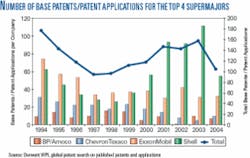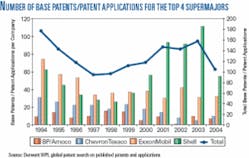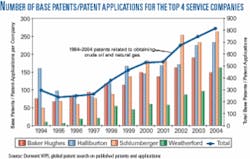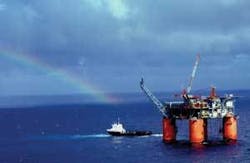Deep Water = Special Challenges
“I see three big challenges we’re fighting to overcome in deepwater projects,” said Bill Donlon, Shenzi Subsea Team Lead for BHP Billiton, the world’s largest diversified resources company.
In no particular order of relevance, Donlon listed key deepwater issues as including:
1. Efforts to produce wells at greater distances from existing infrastructure or from reservoirs that need aquifer support and/or artificial lift. The economic driver for producing to existing infrastructure is the significant cost reduction of development (vs. building new facilities) and the proven operability of existing systems.
2. The cost of subsea interventions. As the number of subsea wells increases, Donlon sees a substantial market developing for vessels and systems that are dedicated to subsea interventions - and less expensive than drilling rigs.
3. Increasingly challenging environments - in both productive reservoirs and the oceans under which they reside - as exploration migrates into ever-deeper water. As examples, Donlon cites development projects requiring design pressures greater than 15,000 psi, and design temperatures greater than 325 degrees Fahrenheit and reservoir depths greater than 25,000 feet - not to mention loop currents, escarpment currents, and hurricane events.
Regarding technical solutions for these issues, Donlon said the challenge of greater distances is being addressed with electrically heated flowlines, improved (lower concentration) chemical inhibitors and distribution systems, and combined separation and pumping technologies. He sees promising subsea intervention solutions to include the development of riserless modular subsea intervention systems from various vessel types. Approaches to deal with challenging environments, he said, are as unique as the companies and individuals developing them. For example, if a company has resources or sees opportunities in “frontier” (such as a high-pressure and/or very deep-water) environments, that company may be developing proprietary material technologies or designs to accommodate the conditions
“As engineers, we’re sometimes faced with very promising prospects that exist in environments we’ve never designed for before,” Donlon said. “Our challenge is to design systems that can operate effectively in those environments.”
When asked his opinion about what may be “the next big thing” in offshore oil and gas development, Donlon said he believes it will be a step change in the distance a reservoir can be from existing infrastructure and still be produced profitably.
“I think it will most likely involve a combination of technologies, including all electric (no hydraulic) control systems, subsea pumping (with or without subsea separation), and flow assurance technologies,” he said. “This scenario is possibly decades away from being reality, but I think it could result in the monetization of stranded assets and open up more markets to profitable development.”
It’s The Pipe
Sometimes overlooked as a “technology” is a basic component of any subsea production system: the pipe itself. A leader in advancing piping designs has been Wellstream, which was spun-off from former parent company Halliburton in 2003. With specially designed and manufactured pipe now in service throughout the world, Wellstream has successfully delivered flowlines, jumpers, service lines and risers from 2-inch to 16-inch diameters, with pressure ratings up to 15,000 psi, and boasts industry’s deepest underwater application of pipe (in Brazil’s Campos Basin).
Who’s Funding Technology Development?
Oil and gas technology development - and who is investing in it - was examined by consultants Chris Bakewell and Chris Horsley of CRA International’s intellectual property practice (formerly InteCap, a subsidiary of Charles River Associates) in a study published last summer in Oil & Gas Financial Journal. One conclusion from the study was the energy price instability has greatly influenced the oil and gas industry’s spending on, and utilization of, the latest technology.
Fearing a replay of the boom-bust that occurred in the 1970s and 1980s, major oil companies have trimmed their research and development budgets in an attempt to cut operating costs. The result has been lagging innovation.
The caution exhibited by the major oil companies, Bakewell and Horsley found, is illustrated by the number of patents applied for in recent years. Between 1994 and 2004, the rate at which the majors applied for patents declined from an average of 174 per year to 104 annually. During the same ten-year period, patent applications from a handful of oilfield service companies (including Baker Hughes, Halliburton, Schlumberger and Weatherford) more than doubled from 297 a year to 810.
null
While these figures make it clear that the super majors themselves are not filing for many patents, they are likely still acquiring the technology, either by commissioning others to develop it or by acquiring the smaller companies altogether. Whichever conclusion you choose to accept, the call for technical innovation and investment in R&D is urgent.
“I think the equipment is already there, it is just a matter of paying for it,” Pappas said. “I see the operators paying for these things, but I also see the service companies leading them to the trough by pointing out the advantages of some of the new approaches and convincing the operators that they’re going to be reliable.”
An irony of this philosophical change, Pappas said, is that many of the “experts” now working in the service and supply sector were employed on the E & P side of the business before the economic downturns of the 80s and early 90s resulted in significant staff downsizing and project outsourcing.
A 25-year-plus industry veteran, Pappas also cited the collaborative environment among energy professionals worldwide as a key component in the advancement of exploration and production technology. He said that the idea-sharing and technology transfer initiated through initiatives of organizations such as the Society of Petroleum Engineers (SPE) and Society for Underwater Technology (SUT) - as well as industry/trade organizations such as the Independent Petroleum Association of America (IPAA) and the American Petroleum Institute (API) - is vital to assure that theory is translated rapidly into productivity.
HIPPS: Reliability & Cost Savings
While it is certainly not a new technology, several subsea operators and service providers cited advancements in High Integrity Pipeline Protection Systems (HIPPS) as holding substantial potential for reducing deepwater production costs.
The concept of HIPPS involves the ability to immediately (in two seconds or less) execute the shutdown of underwater flowlines via automated, extremely reliable isolation valves to prevent subsea overpressurization and line failure. Although HIPPS technology has been employed successfully for more than 20 years, the latest application breakthrough is installation of the systems closer to the wellhead - on the seabed instead of topside.
Traditionally, the subsea flowlines have been designed to withstand the wellhead pressure, but operators are now recognizing that reliable underwater HIPPS installations can help them achieve major project cost savings by allowing the “de-rating” of flow lines. In simple terms, the HIPPS provides a fail-safe method for handling high pressures in pipe that wouldn’t otherwise be considered suitable for the task.
A key worldwide supplier of HIPPS technology is Vetco Gray, which says that the systems can be beneficial when applied to any pipeline over 20 kilometers (about 12 miles) and 5,000 psi. Vetco Gray also suggests the applicability of HIPPS for deepwater projects with long pipelines tied back to platforms in shallower waters. According to information provided by the company, the Vetco Gray HIPPS system is unique because the safety critical voting logic is 100% hardware based.
Estimated savings on subsea production piping, when equipped with the latest generation HIPPS, range as high as 25% - which translates into huge number considering the overall cost of offshore operations.
Operating Reliability
Stretched thin as they seek new productive zones around the world, many offshore operators have recognized the value of consolidating and outsourcing their inspection, repair and maintenance responsibilities to firms that specialize in providing such services. One such services provider is Technip, an engineering, technology and construction organization based in Paris. A notable Technip project is a multi-million dollar agreement with Amerada Hess that includes subsea services management for a collection of Hess-operated production facilities in the North Sea. Under the three-year contract, Technip is delivering inspection, repair, maintenance and engineering services to subsea infrastructure from the wellhead to topside.
In the Gulf of Mexico, operators look to a firm such as The Cross Group for a variety of offshore services. Based in Houma, La., Cross supports the industry with a wide range of equipment, services and support, and has earned the respect of many with their contributions to recovery from last year’s spate of Gulf Coast hurricanes.



